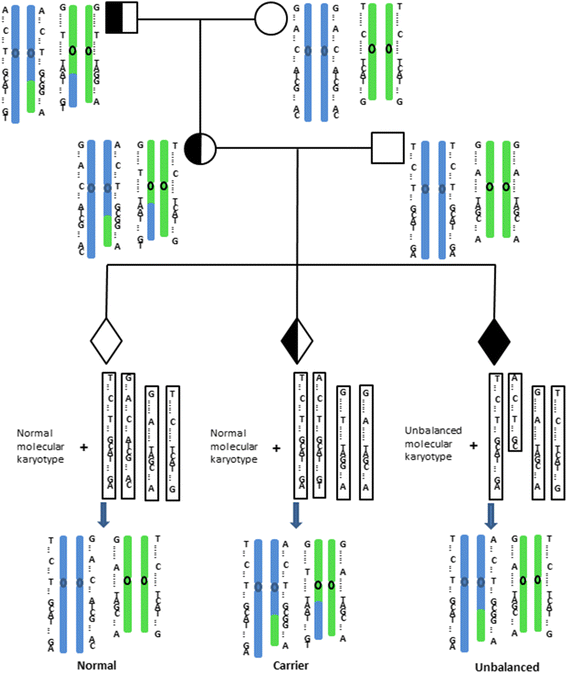The establishment and application of preimplantation genetic haplotyping in embryo diagnosis for reciprocal and Robertsonian translocation carriers
- PMID: 29041973
- PMCID: PMC5646120
- DOI: 10.1186/s12920-017-0294-x
The establishment and application of preimplantation genetic haplotyping in embryo diagnosis for reciprocal and Robertsonian translocation carriers
Abstract
Background: Preimplantation genetic diagnosis (PGD) is now widely used to select embryos free of chromosomal copy number variations (CNV) from chromosome balanced translocation carriers. However, it remains a difficulty to distinguish in embryos between balanced and structurally normal chromosomes efficiently.
Methods: For this purpose, genome wide preimplantation genetic haplotyping (PGH) analysis was utilized based on single nucleotide polymorphism (SNP) microarray. SNPs that are heterozygous in the carrier and, homozygous in the carrier's partner and carrier's family member are defined as informative SNPs. The haplotypes including the breakpoint regions, the whole chromosomes involved in the translocation and the corresponding homologous chromosomes are established with these informative SNPs in the couple, reference and embryos. In order to perform this analysis, a reference either a translocation carrier's family member or one unbalanced embryo is required. The positions of translocation breakpoints are identified by molecular karyotypes of unbalanced embryos. The recombination of breakpoint regions in embryos could be identified.
Results: Eleven translocation families were enrolled. 68 blastocysts were analyzed, in which 42 were unbalanced or aneuploid and the other 26 were balanced or normal chromosomes. Thirteen embryos were transferred back to patients. Prenatal cytogenetic analysis of amniotic fluid cells was performed. The results predicted by PGH and karyotypes were totally consistent.
Conclusions: With the successful clinical application, we demonstrate that PGH was a simple, efficient, and popularized method to distinguish between balanced and structurally normal chromosome embryos.
Keywords: Breakpoint; Preimplantation genetic haplotyping; Reciprocal translocation; Robertsonian translocation; Single nucleotide polymorphism.
Conflict of interest statement
Ethics approval and consent to participate
Written informed consent was obtained from each family and this study was approved by the Ethics Committee for Human Subject research of the Obstetrics and Gynecology Hospital, Fudan University.
Consent for publication
We obtained the consent to publish their clinical data from the patients in this study.
Competing interests
The authors declare that they have no competing interests. Daru Lu, one of the authors, is the member of the Editorial Board of this journal.
Publisher’s Note
Springer Nature remains neutral with regard to jurisdictional claims in published maps and institutional affiliations.
Figures


Similar articles
-
BasePhasing: a highly efficient approach for preimplantation genetic haplotyping in clinical application of balanced translocation carriers.BMC Med Genomics. 2019 Mar 18;12(1):52. doi: 10.1186/s12920-019-0495-6. BMC Med Genomics. 2019. PMID: 30885195 Free PMC article.
-
Single-nucleotide polymorphism microarray-based preimplantation genetic diagnosis is likely to improve the clinical outcome for translocation carriers.Hum Reprod. 2013 Sep;28(9):2581-92. doi: 10.1093/humrep/det271. Epub 2013 Jul 11. Hum Reprod. 2013. PMID: 23847111
-
Preliminary analysis of numerical chromosome abnormalities in reciprocal and Robertsonian translocation preimplantation genetic diagnosis cases with 24-chromosomal analysis with an aCGH/SNP microarray.J Assist Reprod Genet. 2018 Jan;35(1):177-186. doi: 10.1007/s10815-017-1045-9. Epub 2017 Sep 18. J Assist Reprod Genet. 2018. PMID: 28921398 Free PMC article.
-
Successful pregnancy outcomes after preimplantation genetic diagnosis (PGD) for carriers of chromosome translocations.Hum Fertil (Camb). 2001;4(3):168-71. doi: 10.1080/1464727012000199252. Hum Fertil (Camb). 2001. PMID: 11591275 Review.
-
Translocation breakpoints of chromosome 3 in male carriers: a report of twelve cases and a review of the literature.Turk J Med Sci. 2018 Feb 23;48(1):150-156. doi: 10.3906/sag-1704-1. Turk J Med Sci. 2018. PMID: 29479975 Review.
Cited by
-
Identification and interruption of inheritance of familial cryptic translocations: A case report.Mol Genet Genomic Med. 2024 Jan;12(1):e2356. doi: 10.1002/mgg3.2356. Mol Genet Genomic Med. 2024. PMID: 38284442 Free PMC article.
-
A Retrospective Analysis of Robertsonian Translocations from a Single Center in China.Reprod Sci. 2024 Mar;31(3):851-856. doi: 10.1007/s43032-023-01398-3. Epub 2023 Nov 6. Reprod Sci. 2024. PMID: 37932552 Free PMC article.
-
Meiotic Heterogeneity of Trivalent Structure and Interchromosomal Effect in Blastocysts With Robertsonian Translocations.Front Genet. 2021 Feb 16;12:609563. doi: 10.3389/fgene.2021.609563. eCollection 2021. Front Genet. 2021. PMID: 33679881 Free PMC article.
-
Identifying Balanced Chromosomal Translocations in Human Embryos by Oxford Nanopore Sequencing and Breakpoints Region Analysis.Front Genet. 2022 Jan 18;12:810900. doi: 10.3389/fgene.2021.810900. eCollection 2021. Front Genet. 2022. PMID: 35116057 Free PMC article.
-
Preimplantation genetic testing for structural rearrangements by genome-wide SNP genotyping and haplotype analysis: a prospective multicenter clinical study.EBioMedicine. 2025 Jan;111:105514. doi: 10.1016/j.ebiom.2024.105514. Epub 2024 Dec 20. EBioMedicine. 2025. PMID: 39708428 Free PMC article.
References
-
- Lim CK, Cho JW, Song IO, Kang IS, Yoon YD, Jun JH. Estimation of chromosomal imbalances in preimplantation embryos from preimplantation genetic diagnosis cycles of reciprocal translocations with or without acrocentric chromosomes. Fertil Steril. 2008;90:2144–2151. doi: 10.1016/j.fertnstert.2007.10.035. - DOI - PubMed
MeSH terms
LinkOut - more resources
Full Text Sources
Other Literature Sources
Miscellaneous

